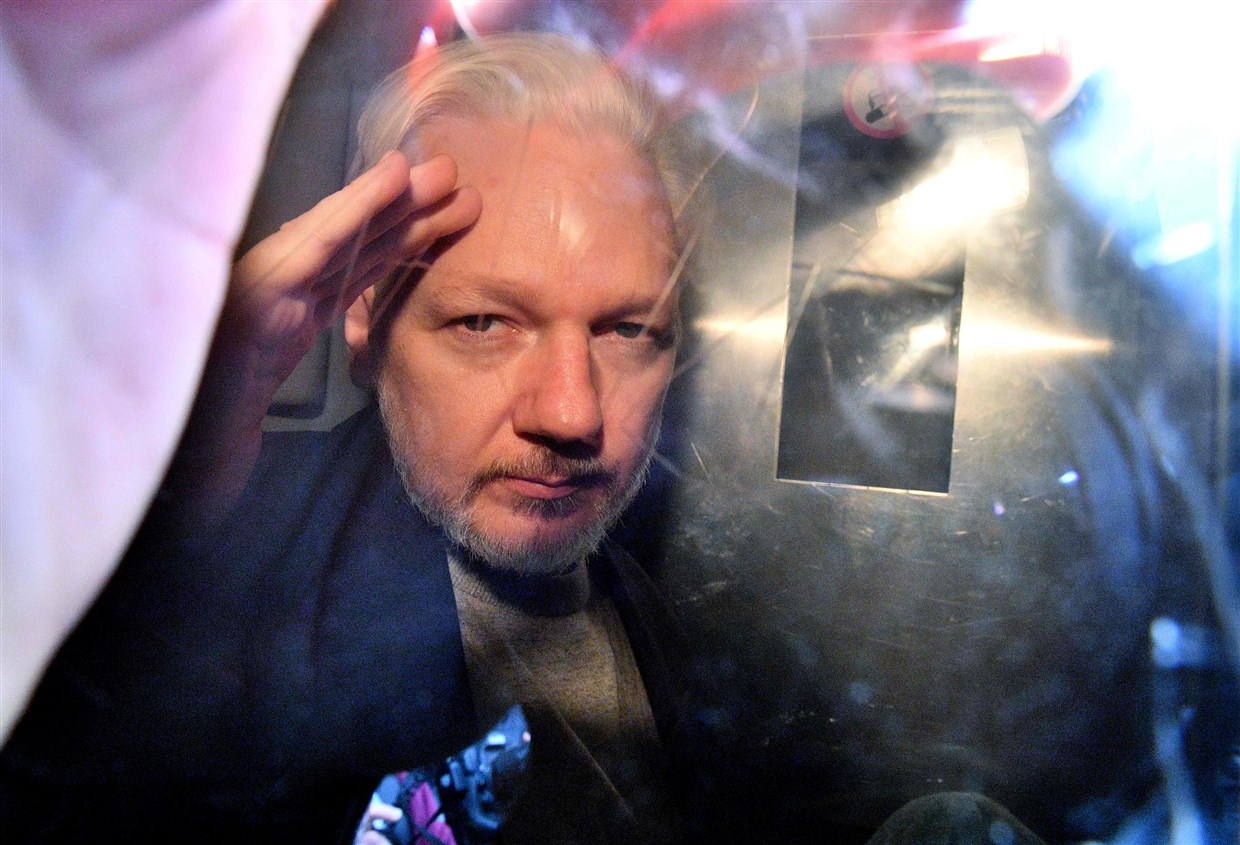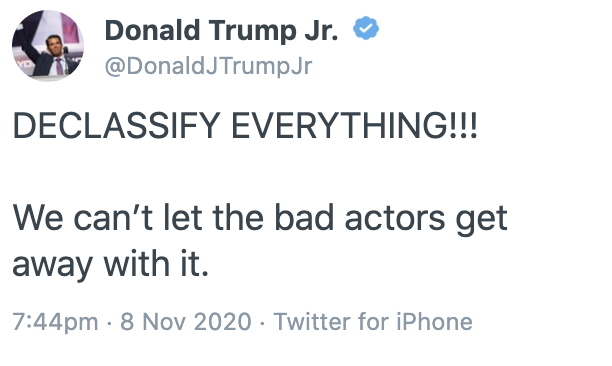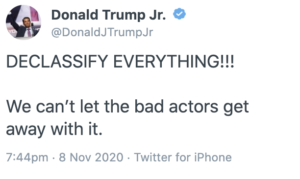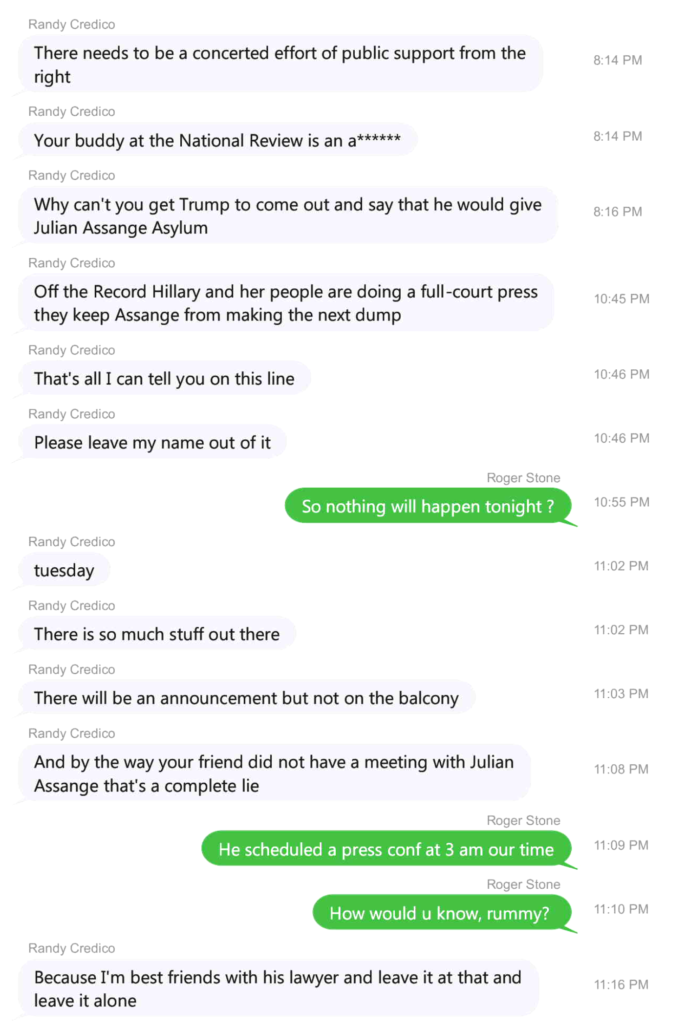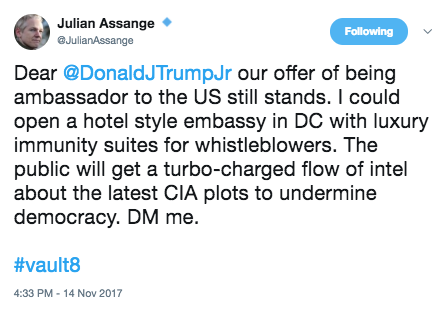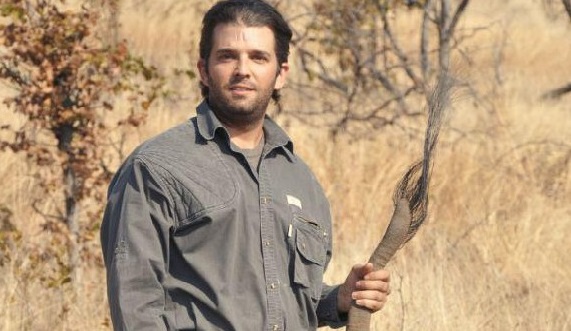The Yahoo Story about All the Things CIA Wasn’t Allowed to Do Against WikiLeaks
When last we saw Zach Dorfman get a big scoop, he managed to present claims about Eric Swalwell appropriately cooperating with the FBI in a counterintelligence investigation so wildly out of context that the story fed false claims about Swalwell for most of a year.
His big story about Mike Pompeo’s vendetta against WikiLeaks — with Sean Naylor and Michael Isikoff — is bound to be a similar example.
Wherein paragraph 100-something debunks paragraphs 1 and 2
The first two paragraphs claim that there were discussions about assassinating Julian Assange.
In 2017, as Julian Assange began his fifth year holed up in Ecuador’s embassy in London, the CIA plotted to kidnap the WikiLeaks founder, spurring heated debate among Trump administration officials over the legality and practicality of such an operation.
Some senior officials inside the CIA and the Trump administration even discussed killing Assange, going so far as to request “sketches” or “options” for how to assassinate him. Discussions over kidnapping or killing Assange occurred “at the highest levels” of the Trump administration, said a former senior counterintelligence official. “There seemed to be no boundaries.”
Paragraph 12 says that lots of those things described in paragraphs one and two weren’t approved.
There is no indication that the most extreme measures targeting Assange were ever approved, in part because of objections from White House lawyers, but the agency’s WikiLeaks proposals so worried some administration officials that they quietly reached out to staffers and members of Congress on the House and Senate intelligence committees to alert them to what Pompeo was suggesting. “There were serious intel oversight concerns that were being raised through this escapade,” said a Trump national security official.
Around about paragraph 67 the piece describes Mike Pompeo asking for “the art of the possible,” something CIA Directors have a history of doing as a way to think outside the box.
Soon after the speech, Pompeo asked a small group of senior CIA officers to figure out “the art of the possible” when it came to WikiLeaks, said another former senior CIA official. “He said, ‘Nothing’s off limits, don’t self-censor yourself. I need operational ideas from you. I’ll worry about the lawyers in Washington.’” CIA headquarters in Langley, Va., sent messages directing CIA stations and bases worldwide to prioritize collection on WikiLeaks, according to the former senior agency official.
Around the 90s, Yahoo claims someone learned second-hand that Trump asked about killing Assange, but then suggests that wasn’t real, then describes top CIA officials talking about killing Assange, then admits such plans may have never gotten to the White House.
Some discussions even went beyond kidnapping. U.S. officials had also considered killing Assange, according to three former officials. One of those officials said he was briefed on a spring 2017 meeting in which the president asked whether the CIA could assassinate Assange and provide him “options” for how to do so.
“It was viewed as unhinged and ridiculous,” recalled this former senior CIA official of the suggestion.
It’s unclear how serious the proposals to kill Assange really were. “I was told they were just spitballing,” said a former senior counterintelligence official briefed on the discussions about “kinetic options” regarding the WikiLeaks founder. “It was just Trump being Trump.”
Nonetheless, at roughly the same time, agency executives requested and received “sketches” of plans for killing Assange and other Europe-based WikiLeaks members who had access to Vault 7 materials, said a former intelligence official. There were discussions “on whether killing Assange was possible and whether it was legal,” the former official said.
Yahoo News could not confirm if these proposals made it to the White House. Some officials with knowledge of the rendition proposals said they had heard no discussions about assassinating Assange.
And then well past paragraph 100, Yahoo admits the plans to assassinate Assange went nowhere, in significant part because doing so would be illegal.
A primary question for U.S. officials was whether any CIA plan to kidnap or potentially kill Assange was legal. The discussions occurred under the aegis of the agency’s new “offensive counterintelligence” authorities, according to former officials. Some officials thought this was a highly aggressive, and likely legally transgressive, interpretation of these powers.
Without a presidential finding — the directive used to justify covert operations — assassinating Assange or other WikiLeaks members would be illegal, according to several former intelligence officials. In some situations, even a finding is not sufficient to make an action legal, said a former national security official. The CIA’s newfound offensive counterintelligence powers regarding WikiLeaks would not have stretched to assassination. “That kind of lethal action would be way outside of a legitimate intelligence or counterintelligence activity,” a former senior intelligence community lawyer said.
In the end, the assassination discussions went nowhere, said former officials.
The idea of killing Assange “didn’t get serious traction,” said a former senior CIA official. “It was, this is a crazy thing that wastes our time.”
As to the discussions of kidnapping Assange, both the UK and NSC nixed those ideas, though White House Counsel lawyer John Eisenberg (who is presented as the hero of the Yahoo story, and who was a national security lawyer at DOJ during the Bush Administration when such things did get approved) worried that CIA would do it without alerting him and others, and so pressed DOJ to indict Assange if they were going to.
“There was a discussion with the Brits about turning the other cheek or looking the other way when a team of guys went inside and did a rendition,” said a former senior counterintelligence official. “But the British said, ‘No way, you’re not doing that on our territory, that ain’t happening.’” The British Embassy in Washington did not return a request for comment.
In addition to diplomatic concerns about rendition, some NSC officials believed that abducting Assange would be clearly illegal. “You can’t throw people in a car and kidnap them,” said a former national security official.
In fact, said this former official, for some NSC personnel, “This was the key question: Was it possible to render Assange under [the CIA’s] offensive counterintelligence” authorities? In this former official’s thinking, those powers were meant to enable traditional spy-versus-spy activities, “not the same kind of crap we pulled in the war on terror.”
In short, this is a very long story that spends thousands of words admitting that its lead overstates how seriously this line of thought, particularly assassination, was pursued.
I will have lots more to say about several things that discredit this story. But for now that’s the important thing: The story admits that the story oversells its lead.
Yahoo describes the changing view regarding WikiLeaks
The story is useful because it lays out a chronology that few people understand, how over years the US view on Assange gradually changed (the view is entirely based on “former” officials and likely doesn’t reflect even what happened with Assange in the last years of the Trump Administration). The events it describes that led to a gradual change in the way the US treated Assange as depicted in this story are:
- In response to the 2010 releases, the Obama Administration, “restricted investigations into Assange and WikiLeaks”
- “In the wake of the Snowden revelations, the Obama administration allowed the intelligence community to prioritize collection on WikiLeaks,” no longer requiring a warrant for intel; but when “top intelligence officials” tried to get the White House to deem people like Laura Poitras and Glenn Greenwald “information brokers,” Obama refused
- In spite of the changes described as occurring in 2013, in 2015 DOJ remained, “very protective,” of its authorities over whether to charge Assange and whether to treat WikiLeaks “like a media outlet”
- “The events of 2016 ‘really crystallized’ U.S. intelligence officials’ belief that the WikiLeaks founder ‘was acting in collusion with people who were using him to hurt the interests of the United States,’ … But there was still ‘sensitivity on how we would collect on them.'” [Yahoo says NSA “surveilled” Guccifer 2.0’s Twitter accounts but we know that DOJ obtained warrants to read them, as well, which it doesn’t mention]
- Yahoo presents a series of seemingly conflicting claims about how things changed in 2016, but does say that shortly before Trump took over Obama’s view on WikiLeaks underwent a “sea change”
- On April 13, 2017, over a month after the first Vault 7 releases, Pompeo declared WikiLeaks a non-state hostile intelligence agency, thereby accessing “offensive counterintelligence” activities to use against WikiLeaks, including disruption efforts (though the article suggests none were ever used); this label did result in far more collection on WikiLeaks associates traveling around the world
- In summer 2017, Pompeo embraced proposals to kidnap Assange, which was ultimately pitched to the British, but they refused and NSC officials argued it would be illegal
- In December 2017, the Five Eyes worked together to thwart a believed Russian exfiltration attempt, and on the same day, DOJ charged Assange by complaint
- In April 2019, Assange was booted from the Embassy and arrested under a single CFAA count, which DOJ has twice superseded (Yahoo makes no mention of the second superseding indictment and the story seems to drop well before the end of the Trump Administration; it makes no mention of whether Gina Haspel continued the policies pursued by Pompeo after he moved to State in 2018)
The timeline laid out here conflicts with virtually everything Assange claimed about the genesis of his charges during his extradition hearing: showing that Assange’s help getting Snowden out of Hong Kong is what started the process of revising views of WikiLeaks, showing that the US changed their understanding of Assange in 2016, not in 2017, as Assange repeatedly claimed in his extradition hearing, and showing that things really started ratcheting up after the Vault 7 release, at a time when Assange was also under investigation for several things unrelated to journalism (though Yahoo doesn’t mention those investigations, even though they are public), and was therefore separate from Trump’s election or Jeff Sessions’ later leak-driven commitment to crack down on journalists.
In short, amidst a jillion words making claims that the article itself discredits, the article proves that Assange lied, repeatedly, in his extradition hearing, and that the precipitating event in originally charging him was credible information about a Russian exfiltration plot.
Roger Stone reporter Michael Isikoff appears to be unfamiliar with the entire Roger Stone case
One thing that this story never explains is why, if the entire Trump Administration were so opposed to Assange as they claim, Pompeo would have to declare WikiLeaks a non-state hostile intelligence service rather than relying on a Presidential finding to spy on WikiLeaks’ associates.
The immediate question facing Pompeo and the CIA was how to hit back against WikiLeaks and Assange. Agency officials found the answer in a legal sleight of hand. Usually, for U.S. intelligence to secretly interfere with the activities of any foreign actor, the president must sign a document called a “finding” that authorizes such covert action, which must also be briefed to the House and Senate intelligence committees. In very sensitive cases, notification is limited to Congress’s so-called Gang of Eight — the four leaders of the House and Senate, plus the chairperson and ranking member of the two committees.
But there is an important carveout. Many of the same actions, if taken against another spy service, are considered “offensive counterintelligence” activities, which the CIA is allowed to conduct without getting a presidential finding or having to brief Congress, according to several former intelligence officials.
Often, the CIA makes these decisions internally, based on interpretations of so-called “common law” passed down in secret within the agency’s legal corps. “I don’t think people realize how much [the] CIA can do under offensive [counterintelligence] and how there is minimal oversight of it,” said a former official.
That’s what gave Pompeo broader authorities to operate on his own (and thereby creating the risk he might try to assassinate Assange without White House knowledge). But it’s also what limited his options legally. Had Pompeo gotten a finding, kidnapping and assassination would be less obviously prohibited, and just the Gang of Eight would have been briefed. But by making this announcement publicly, everyone learned about it. Ron Wyden predictably raised concerns (and there was a perennial battle over whether Congress would agree with Pompeo’s label as a sense of Congress).
Effectively, Pompeo got fewer authorities and more political pushback, literally the opposite of why Yahoo claims why he went this route.
I don’t know the answer. But I do know that this story’s treatment of Trump is bizarre and ignores a lot of known facts, so it’s possible the answer is the most obvious one: Pompeo couldn’t get a Presidential finding because the President wouldn’t sign off.
As noted above, the article does describe that a source heard second-hand that Trump asked for options to kill Assange, though it doesn’t date it more specifically than spring 2017 and dismisses the statement as one of Trump’s routine attacks.
The story describes that Mike Pompeo was terrified of briefing Trump on the Vault 7 breach, the first releases of which were published on March 7, 2017.
Pompeo, apparently fearful of the president’s wrath, was initially reluctant to even brief the president on Vault 7, according to a former senior Trump administration official. “Don’t tell him, he doesn’t need to know,” Pompeo told one briefer, before being advised that the information was too critical and the president had to be informed, said the former official.
It doesn’t explain, then, whether Pompeo, or Jim Comey, was the source of the briefing that Trump promptly shared with Tucker Carlson literally the day when the FBI would first interview suspected Vault 7 source Joshua Schulte in an urgent attempt to prevent him from fleeing the country with his diplomatic passport. It sure as hell doesn’t explain how the President, in his first known big leak of classified information, almost blew the entire Vault 7 investigation, and how that’s consistent with a plan to assassinate Assange.
Even crazier, especially given Michael Isikoff’s participation in the story, is that there’s no mention of the disclosures that came out as part of the Roger Stone investigation and the Mueller investigation more generally.
No later than November 15 (and possibly even before the election), Trump’s rat-fucker was working with Assange’s lawyer brokering a pardon deal.
In April, Stone called on Pompeo to resign for his comments in the wake of Vault 7.
Stone took to InfoWars on April 18, calling on Pompeo to either provide proof of those Russian ties or resign, defending the release of the Vault 7 tools along the way.
The Intelligence agencies continue to insist that Julian Assange is an active Russian Agent and that Wikileaks is a Russian controlled asset. The agencies have no hard proof of this claim whatsoever. Assange has said repeatedly that he is affiliated with no nation state but the Intelligence Agencies continue to insist that he is under Russian control because it fits the narrative in which they must produce some evidence of Russian interference in our election because they used this charge to legally justify and rationalize the surveillance of Trump aides, myself included.
[snip]
President Donald Trump said on Oct, 10, 2016 “I love Wikileaks” and Pompeo who previously had praised the whistleblowing operation now called Wikileaks “a non-state hostile Intelligence service often abetted by state actors like Russia”. Mr. Pompeo must be pressed to immediately release any evidence he has that proves these statements. If he cannot do so ,the President should discharge him.
[snip]
Julian Assange does not work for the Russians. Given the import of the information that he ultimately disclosed about the Clinton campaign, the Obama administration and the deep secrets in the CIA’s Vault 7, he has educated the American people about the tactics and technology the CIA has used to spy on ordinary Americans.
Assange personally DMed Stone to thank him for the article, while claiming that Pompeo had stopped short of claiming that WikiLeaks had gotten the stolen DNC emails directly, thereby making WikiLeaks like any other media outlet.
On or about April 19, 2017, Assange, using Target Account 2, wrote to Stone, “Ace article in infowars. Appreciated. But note that U.S. intel is engages in slight of hand maoevers [sic]. Listen closely and you see they only claim that we received U.S. election leaks \”not directly\” or via a \”third party\” and do not know \”when\” etc. This line is Pompeo appears to be getting at with his \”abbeted\”. This correspnds to the same as all media and they do not make any allegation that WL or I am a Russia asset.”
The Mueller investigation even showed that in the very same time period where Pompeo was considering assassination attempts on Assange, Trump’s rat-fucker was leveraging the “highest level of Government” to address Assange’s issues.
On June 10, 2017, according to affidavits submitted as part of the Mueller investigation, Roger Stone DMed Julian Assange and told him he was doing everything he could to “address the issues at the highest level of Government.”
57. On or about June 10, 2017, Roger Stone wrote to Target Account 2, “I am doing everything possible to address the issues at the highest level of Government. Fed treatment of you and Wikileaks is an outrage. Must be circumspect in this forum as experience demonstrates it is monitored. Best regards R.” Target Account 2 wrote back, “Appreciated. Of course it is!”
Nine days after the rat-fucker who had a notebook that recorded all the communications he had with Trump during the election described working at the highest level of government to help Assange, Trump attempted to shut down the entirety of the hack-and-leak investigation.
On June 19, 2017, according to the Mueller Report, the President dictated a message for Corey Lewandowski to take to Jeff Sessions, telling the (recused) Attorney General to meet with Robert Mueller and order him to limit his investigation only to future election meddling, not the election meddling that had gotten Trump elected.
During the June 19 meeting, Lewandowski recalled that, after some small talk, the President brought up Sessions and criticized his recusal from the Russia investigation.605 The President told Lewandowski that Sessions was weak and that if the President had known about the likelihood of recusal in advance, he would not have appointed Sessions.606 The President then asked Lewandowski to deliver a message to Sessions and said “write this down.” 607 This was the first time the President had asked Lewandowski to take dictation, and Lewandowski wrote as fast as possible to make sure he captured the content correctly.608 The President directed that Sessions should give a speech publicly announcing:
I know that I recused myself from certain things having to do with specific areas. But our POTUS . .. is being treated very unfairly. He shouldn’t have a Special Prosecutor/Counsel b/c he hasn’t done anything wrong. I was on the campaign w/ him for nine months, there were no Russians involved with him. I know it for a fact b/c I was there. He didn’t do anything wrong except he ran the greatest campaign in American history.609
The dictated message went on to state that Sessions would meet with the Special Counsel to limit his jurisdiction to future election interference:
Now a group of people want to subvert the Constitution of the United States. T am going to meet with the Special Prosecutor to explain this is very unfair and let the Special Prosecutor move forward with investigating election meddling for future elections so that nothing can happen in future elections.610
Days after Roger Stone told Julian Assange that he was trying to resolve matters at the highest level of government, the President of the United States tried to issue a back channel order that would shut down the investigation into Assange — and by association, Stone.
And it went on like that for some time, possibly up to the time when Mueller asked Trump about any pardon discussions for Assange. Only after that did Don Jr’s buddy tell former Sputnik employee Cassandra Fairbanks that the pardon discussion was off, whereupon she flew to London to tell Assange herself.
Particularly pertinent to the question of why CIA was working via offensive counterintelligence authorities rather than a Presidential finding, in October, after weeks of prodding from Trump, Pompeo took a meeting with Bill Binney to hear a theory that would have undermined the entire Intelligence Community’s attribution of the DNC hack via which emails shared with WikiLeaks were stolen. According to The Intercept’s report of the meeting, it led others in the Intelligence Community to worry that Pompeo had stopped heeding intelligence, particularly regarding Russia, that Trump didn’t like.
Some senior CIA officials have grown upset that Pompeo, a former Republican representative from Kansas, has become so close to Trump that the CIA director regularly expresses skepticism about intelligence that doesn’t line up with the president’s views. Pompeo has also alienated some CIA managers by growing belligerent toward them in meetings, according to an intelligence official familiar with the matter.
[snip]
[I]ndications of Pompeo’s willingness to support Trump at the risk of tainting the intelligence process have occasionally broken into the open in recent months. In August, the Washington Post reported that Pompeo had taken the unusual step of having the CIA’s Counterintelligence Mission Center, which would likely play a role in any inquiries by the agency into Russian election meddling, report directly to him. That move has raised concerns within the agency that Pompeo is seeking to personally control the CIA’s efforts to investigate accusations of collusion between the Trump campaign and Russia.
At the very least, by fall this put Pompeo in a more precarious position regarding his vendetta against Assange.
The thing is, the hero of this Yahoo story, John Eisenberg, must know parts of this story, because he was a key part of efforts to protect Trump. He played a role in protecting Mike Flynn after he lied to the FBI and an even bigger role in protecting Trump after he tried to coerce election help from Ukraine, so who knows what his motives really are here. But he certainly must know these details … but they don’t show up in the story.
Crazier still, Isikoff must know parts of these stories, because he reported on the Stone case.
Yet not only don’t those details appear in this story, but the depiction of an entire Administration, save for heroes like John Eisenberg, intent on assassinating Julian Assange is inconsistent with those public facts about Trump’s repeated efforts to undermine any attribution implicating Assange to say nothing of discussions of pardons for Assange.
The truth may be somewhere in the middle, with Trump vacillating between wanting to kill Assange and wanting to liberate him (in this story, however, he’s quoted complaining that Assange was treated badly). But what the President did to undermine the investigation targeting Assange seems to be as important a part of this story as the claim that he mouthed off once about the possibility of assassinating Assange, something he has done with a slew of other journalists and perceived enemies.
The UC Global timeline
Among all the 30 sources cited in the story and the reports that CIA ratcheted up spying on WikiLeaks associates under Pompeo, Yahoo didn’t succeed in getting more clarity on the — by the end of 2017 — very intrusive surveillance of Assange inside the Ecuadorian Embassy by a contractor called UC Global, citing just one source confirming the US did have access to video surveillance without even naming UC Global or revealing which agency UC Global was working with.
A former U.S. national security official confirmed that U.S. intelligence had access to video and audio feeds of Assange within the embassy but declined to specify how it acquired them.
So instead of new information from those 30 sources, Yahoo instead relies on the prior reports from some UC Global whistleblowers. As I noted here, based on their Assange extradition hearing testimony, one of them is quite credible while the other is far less so.
It’s important that Yahoo relies on the whistleblowers, because it provides another way, along with the public details they inexplicably leave out, to test their narrative. Yahoo describes, accurately, that UC Global was sharing information with the US by mid-2017 (the credible witness described key developments in June and July).
By late 2015, Ecuador had hired a Spanish security company called UC Global to protect the country’s London embassy, where Assange had already spent several years running WikiLeaks from his living quarters. Unbeknownst to Ecuador, however, by mid-2017 UC Global was also working for U.S. intelligence, according to two former employees who testified in a Spanish criminal investigation first reported by the newspaper El País.
Yahoo doesn’t note, however, that data collection first started to expand in 2016, and formal vetting for what was presumably this relationship started by January 24, 2017, just one day after Pompeo was confirmed.
I also recall that once Donald Trump won the elections, at the end of 2016, the collection of information intensified as Morales became more obsessed with obtaining as much information as possible.
[snip]
On 24 January 2017, once Donald Trump had acceded to the presidency of the United States, David Morales sent a message over Telegram in which he wrote, “Well, I want you to be alert because I am informed that we are being vetted, so everything that is confidential should be encrypted […] That’s what I’m being told. Everything relates to the UK issue. I am not worried about it, just be alert […] The people vetting are our friends in the USA”.
That is, this process started after WikiLeaks’ cooperation with Russia in 2016 caused a “sea change” in US treatment of Assange, but before Pompeo’s vendetta in response to Vault 7.
And while the surveillance absolutely ratcheted up during that summer (so potentially consistent with Pompeo’s vendetta, but also at a time when WikiLeaks was also under several different criminal investigations), Yahoo neglects to mention that the really intrusive surveillance came in December, at the same time (it reports) that the IC had credible reports of an exfiltration attempt.
In early December 2017, I was instructed by David Morales to travel with a colleague to install the new security cameras. I carried out the new installation over the course of several days. I was instructed by Morales not to share information about the specifications of the recording system, and if asked to deny that the cameras were recording audio. I was told that it was imperative that these instructions be carried out as they came, supposedly, from the highest spheres. In fact, I was asked on several occasions by Mr. Assange and the Political Counsellor Maria Eugenia whether the new cameras recorded sound, to which I replied that they did not, as my boss had instructed me to do. Thus, from that moment on the cameras began to record sound regularly, so every meeting that the asylee held was captured. At our offices in UC Global it was mentioned that the cameras had been paid for twice, by Ecuador and the United States, although I have no documentary evidence to corroborate this assertion.
The story Yahoo tells significantly amounts to Mike Pompeo proposing some illegal options to take out Assange, only to be thwarted by (at a minimum) the lawyers in place to prevent such things — though there’s good reason to believe DOJ played a big role in it too. And then, at a time when Pompeo had lost or was losing his bid to pursue illegal activities, the Five Eyes (presumably including Australia) identified and countered a Russian exfiltration attempt.
That presumably changed a lot of things about how the IC dealt with Assange. But those details don’t appear in this story. Aside from the mentions of DOJ successfully retaining the gatekeeper role on these questions in 2015 and 2017 (something I have some, albeit limited, reason to believe continued through 2019), the story doesn’t consider — at all! — the various criminal investigations at the time, not even the one that Isikoff has covered in the past.
Crazier still, it presents this as a story about the Trump Administration, while ignoring public details about a key player in that Administration — some guy named Trump — was doing that at the least conflicted with Pompeo’s actions.
Pompeo is and was batshit crazy and I’m glad, for once, the lawyers managed to rein in the CIA Director. But this seems to be, largely, a story about crazy Mike Pompeo being reined in by lawyers.

